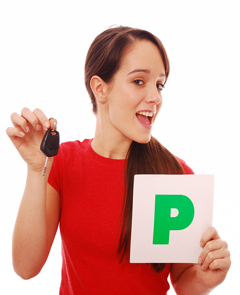 The Practical Driving Test is a 40 minute test in total with various sections.
The Practical Driving Test is a 40 minute test in total with various sections.
-
This part of the Test is carried out at the beginning of the test when you reach the car.
Failure to answer one of the questions will result in one "driving fault" being recorded.
Candidates will not fail for being unable to answer these questions.
The following are sample questions from the Driving Standards Agency website.
Q: Open the bonnet, identify where the brake fluid reservoir is, and tell me how you would check that you have a safe level of hydraulic brake fluid.
A:
Q: Open the bonnet, identify where you would check the engine oil level and tell me how you would check that the engine has sufficient oil.
A:
Q: Open the bonnet, identify where you would check the engine coolant level and tell me how you would check that the engine has the correct level.
A:
Q: Tell me how you would check that the brake lights are working on this car.
A:
Q: Tell me how you would check that the brakes are working before starting a journey.
A:
Q: Tell me where you would find the information for the recommended tyre pressures for
this car and how tyre pressures should be checked.
A:
Q: Tell me how you would know if there was a problem with your anti lock braking system.
A:
Q: Tell me how you make sure your head restraint is correctly adjusted so it provides the best protection in the event of a crash.
A:
Q: Show me/explain how you would check that the power-assisted steering is working before starting a journey.
A:
Q: Show me how you would check that the headlights and tail lights are working.
A:
Q: Show me how you would check that the brake lights are working on this car. (I can assist you, if you need to switch the ignition on, please don't start the engine).
A:
Q: Open the bonnet identify where the windscreen washer reservoir is, and tell me how you would check the windscreen washer level.
A:
Q: Tell me how you would check the tyres to ensure that they have sufficient tread depth and that their general condition is safe to use on the road.
A:
Q: Show me how you would check that the direction indicators are working.
A:
Q: Show me how you would clean the windscreen using the windscreen washer and wiper.
A:
Q: Show me how you would check that the horn is working (off-road only).
A:
Q: Show me how you would check the parking brake for excessive wear.
A:
Q: Show me how you would set the demister controls to clear all the windows effectively, this should include both front and rear screens.
A:
Q: Show me how you would switch on the rear fog light(s) and explain when you would use it/them. (No need to exit vehicle).
A:
-
During the driving part of the practical test the examiner will ask you to drive on a route with different road conditions. At certain points the examiner will get you to undertake two of the set manoeuvres and optionally the emergency stop.
When travelling, the examiner will tell you in good time which way to go. If you go the wrong way, however, do not panic the as the examiner will not fail you for going the wrong way, but they will mark you down for driving hesitantly or erratically.
At some point in the test the instructor will ask you to undertake a period of independant driving (for about 10 or 15 minutes). Before doing this, however, the instructor will first ask you to stop in a suitable place, and they will then give you directions for certain road signs and routes which you should follow independently to reach a specified destination. After they have given you these instructions, you will then be required to drive along that route with no further instructions or guidance.
It's important to remember that the independent driving portion of the test is designed to assess your ability to follow road signs and plan routes. It is not meant to be a test of your memory, and so this means that if you forget the instructions which the examiner has given, you are allowed to ask again.
The driving faults, during a test, are categorised into minor, serious and dangerous faults. At the end of the test the examiner will total up the number of minor driving faults under each heading and overall. If you commit 16 or more minor driving faults you will unfortunately fail the driving test, or if you commit one or more serious or dangerous driving faults you will also fail the test. The degree of seriousness of each individual fault will be totally dependent on the prevailing conditions at the time. When other road users are affected, a minor fault can immediately become a serious one. Dangerous faults will only be recorded when either the driving examiner or when another road user has been forced to take evasive action to avoid danger.
It is important to remember to stay positive at all times during the test. Not only is this because it will raise your own spirits, but with the extra confidence it gives you you will find yourself driving to a much better standard.
|
|